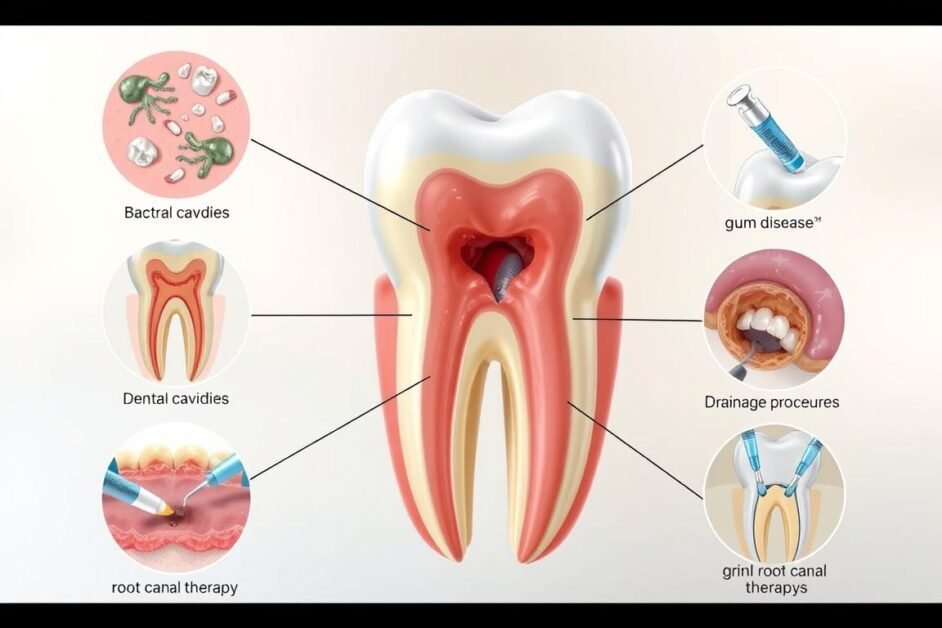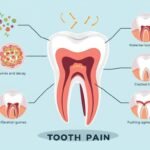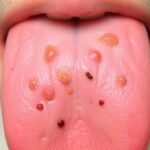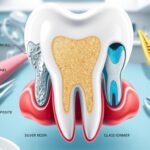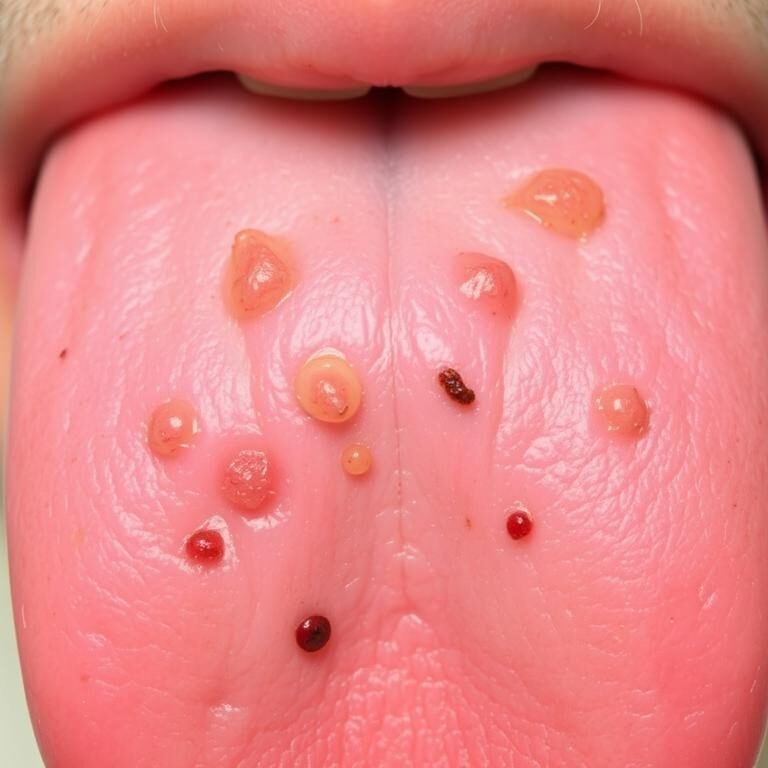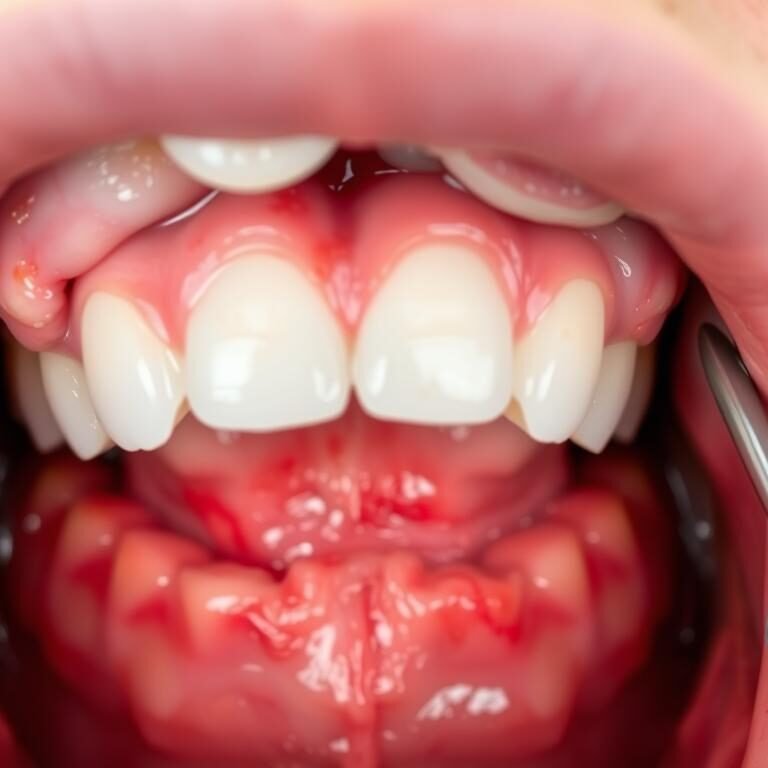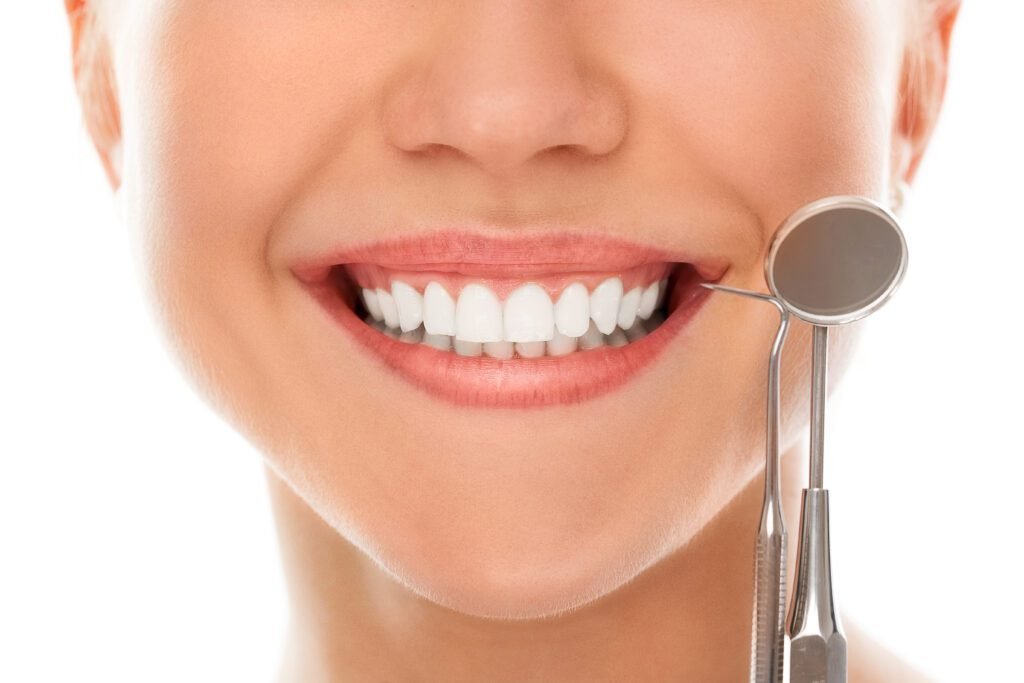Ever felt a sudden, sharp pain in your teeth without warning? You’re not alone. Many people face the scary reality of a dental infection leading to a tooth abscess. This pain is not just uncomfortable; it’s also worrisome.
A tooth abscess is a pocket of pus caused by bacteria. It often starts from untreated cavities or gum disease. Knowing about causes of tooth abscess and treatments for tooth abscess is key to keeping your oral health in check. Ignoring the signs can lead to serious problems, affecting not just your mouth but your whole health.
Understanding the dangers of an untreated dental infection is important. If left untreated, a tooth abscess can turn into severe conditions like sepsis, which is life-threatening. In this article, we’ll dive into the causes of dental abscesses, symptoms to look out for, and effective treatment options. This knowledge can help you feel more confident and take steps towards better dental health.
Table of Contents
What is a Tooth Abscess?
A tooth abscess is a painful dental condition. It happens when bacteria infect the dental pulp inside the tooth. This leads to inflammation and pus formation.
This infection can occur at the tip of the tooth root, known as a periapical abscess. Or, it can happen within the gums, called a periodontal abscess.
The main causes of a tooth abscess include untreated dental cavities and injuries to the tooth. Prior dental work that leads to infection is also a common cause. People with weakened immune systems are at higher risk of complications from a tooth infection.
It’s important to recognize dental abscess symptoms early. Symptoms include severe toothache, which can feel throbbing and spread beyond the tooth. Other signs are a bitter taste in the mouth, bad breath, swollen gums, and sensitivity to hot or cold foods.

Ignoring these symptoms can lead to serious problems like sepsis or losing the affected tooth.
Not treating an abscess can lead to serious health issues. Good dental hygiene helps prevent tooth decay and abscesses. Regular dental check-ups can catch these problems early and prevent pain.
Stages of a Tooth Abscess
A tooth abscess goes through different stages. Each stage is a key moment in the infection’s growth. Knowing these stages helps spot symptoms early and get the right care. Early action can stop tooth loss and other health problems.
Tooth Abscess Stages Pictures
Visual aids like pictures show how a tooth abscess grows. Here are the main stages:
| Stage | Description | Potential Symptoms |
|---|---|---|
| 1. Enamel Decay | Bacteria start to invade the tooth’s enamel. | None or mild sensitivity |
| 2. Dentin Decay | Bacteria move deeper, hitting the dentin layer. | Increased pain, sensitivity to temperature |
| 3. Tooth Pulp Infection | Infection reaches the pulp, causing a lot of pain. | Severe throbbing pain, swelling |
| 4. Tooth Loss | Untreated damage can cause tooth loss. | Persistent pain, possible facial swelling |
How the Infection Progresses
Bacteria first enter the tooth through decay. This causes swelling and inflammation. If not treated, the infection spreads, reaching the pulp and creating pus.
Pressure builds, and the abscess might burst. This can spread the infection to other tissues. Ignoring these signs can lead to serious problems, like for those with weakened immune systems. Knowing how an abscess grows shows why quick treatment is key.
Common Causes of Tooth Abscess
Knowing what causes tooth abscesses is key to avoiding them. Tooth decay, gum injuries, and past dental work are common culprits. These issues let bacteria into the tooth, causing pus and infection.
From Tooth Decay to Gum Injury
Tooth decay is a big problem, affecting 92% of adults in the U.S. at some time. It happens when bacteria damage the enamel, leading to serious issues. Cracks or chips in the enamel make infections more likely.
Studies show nearly half of kids get dental injuries that harm the enamel. If left untreated, these problems can get worse. This lets bacteria reach the pulp chamber, causing 60% of infections.
How Oral Hygiene Affects Risk
Good oral hygiene is vital in preventing tooth abscesses. Bad hygiene leads to plaque and bacteria buildup, increasing cavity risk. This, in turn, raises the chance of an abscess.
Brushing and flossing well can cut cavity risk by 40-50%. Regular dental visits also help. Patients who go often are 60% less likely to need painful procedures like root canals or extractions.
Symptoms of Tooth Abscess
It’s important to know the signs of a tooth abscess to avoid serious problems. This issue can happen to anyone, due to bad dental care or ignored dental issues. The symptoms can vary, but there are key signs to watch for.
Recognizing the Signs of Infection
Common signs of tooth infection include:
- Severe throbbing toothache that can radiate to the jaw, ear, or neck
- Sensitivity to hot or cold foods and drinks
- Swelling of the gums and face
- Bad taste in the mouth, possibly indicating a rupture
- Fever as the body attempts to fight infection
Swelling can affect up to 40% of people with an abscess. About 30% may have trouble opening their mouth or swallowing. If symptoms get worse or you have trouble breathing, seek emergency care right away.
When to Seek Emergency Care
Get help fast if you notice:
- Severe swelling in the face, neck, or jaw
- Difficulty breathing or swallowing
- Fever exceeding 101°F or persistent fever
- Intense pain that does not subside with over-the-counter medications
Not getting treatment quickly can lead to serious issues. Untreated infections can cause sepsis. If you have severe symptoms, getting emergency care is key to avoid more problems.
Understanding the Risks and Complications
The risks of tooth abscess grow if dental infections are not treated. People might face serious health problems. These can spread to the jaw, neck, or even throughout the body.
About 0.3% of untreated tooth abscess cases can lead to sepsis. This is a life-threatening condition that needs quick medical help.
The complications of dental abscess can be severe. Untreated infections might cause dental cysts that harbor infection. Other issues include osteomyelitis, with its bone pain and fever, and cavernous sinus thrombosis, a dangerous brain vein infection.
Ludwig’s angina is another serious condition. It causes severe swelling that can block the airway.
It’s important to recognize the early signs of an untreated tooth infection. Symptoms like swelling, fever, and pain mean you should see a dentist fast. Regular dental visits can greatly reduce the risk of such infections.
The following table outlines various complications arising from untreated tooth abscesses:
| Complication | Symptoms | Severity |
|---|---|---|
| Dental Cysts | Swelling, pain | Moderate to severe |
| Osteomyelitis | Severe bone pain, fever | Severe |
| Cavernous Sinus Thrombosis | Headache, visual changes | Critical |
| Ludwig’s Angina | Swelling in the mouth, difficulty swallowing | Life-threatening |
| Maxillary Sinusitis | Facial pain, fever | Moderate |
In summary, knowing the risks of tooth abscess and their complications helps prevent untreated tooth infections. Being proactive with dental care is key to avoiding serious health problems.
Diagnosis of Tooth Abscess
The first step in diagnosing a tooth abscess is a detailed dental examination by a dentist. This step looks for signs like swelling, redness, and pain, which are common. About 80% of people with a dental abscess have a severe toothache.
Another sign is sensitivity to hot or cold foods and drinks, affecting about 65% of patients. This makes eating and drinking uncomfortable.
A dental x-ray for abscess is also key. It shows how big the infection is and confirms the abscess. This helps the dentist plan the best treatment.
Facial or jaw swelling is seen in about 40% of cases. A bad taste in the mouth happens in 50% of cases. Also, 30% of patients struggle to open their mouths or chew.
In some cases, fever occurs in about 25% of dental abscess cases. If there’s severe swelling or trouble breathing, seek medical help right away. Quick diagnosis is important to avoid serious problems and ensure effective treatment.
Treatment Options for Tooth Abscess
There are several ways to treat a tooth abscess. These methods aim to get rid of the infection and ease the pain. The right treatment depends on how bad the abscess is and the patient’s situation. Common treatments include antibiotics, pain relief, and sometimes draining the abscess.
Antibiotics and Pain Management
Dentists often give antibiotics to fight the infection in a tooth abscess. This helps lower the number of bacteria and stops the infection from spreading. Over-the-counter pain medicines like ibuprofen or acetaminophen help with the pain. These steps are key in managing the symptoms of a tooth abscess.
Drainage Procedures Explained
Sometimes, draining the abscess is needed. This involves making a small cut to let out the pus. It helps reduce pressure and helps the area heal. Depending on the situation, other treatments like root canal therapy might be needed. Getting treatment early is important to avoid losing the tooth or getting a serious infection. Regular dental visits can help prevent abscesses from happening.
| Treatment Option | Description | Purpose |
|---|---|---|
| Antibiotics | Medications to combat bacterial infections. | Reduce infection and swelling. |
| Pain Relievers | Over-the-counter medications for pain. | Provide relief from severe toothache. |
| Drainage | Procedure to remove pus from the abscess. | Alleviate pressure and promote healing. |
| Root Canal Therapy | A procedure to treat infection inside the tooth. | Save the tooth and prevent reinfection. |
Can an Abscessed Tooth Kill You?
It’s important to know if an abscessed tooth can be deadly. Untreated dental infections can lead to severe infections. These infections can be life-threatening, though rare. It’s key to understand the risks to keep yourself safe.
Dental abscesses come from bacterial infections. They can start from bad dental hygiene or untreated cavities. If not treated, the infection can spread to other parts of the body. This can cause serious problems like sepsis or meningitis, which need quick medical help.
Signs of a dental abscess include a severe toothache, swelling, fever, and pain that doesn’t go away. Knowing these symptoms is important. In kids, dental abscesses are common due to poor oral care. In adults, they often come from gum disease.
To treat a dental abscess, a dentist might need to drain it. The problem might be so bad that a root canal or tooth removal is needed. Doctors also give antibiotics to fight the infection. Medicines like Penicillin and Amoxicillin help stop the infection from getting worse.
Going to the dentist regularly can prevent abscesses. Keeping your teeth clean by brushing and flossing helps a lot. Remember, an abscessed tooth can be serious. So, taking care of your teeth is very important.
| Condition | Severity | Potential Outcomes | Common Treatments |
|---|---|---|---|
| Untreated Dental Abscess | Severe | Sepsis, Meningitis | Surgical Drainage, Antibiotics |
| Periapical Abscess in Children | Moderate | Pain, Swelling | Root Canal Treatment |
| Periodontal Abscess in Adults | Severe | Bone Loss, Inflammation | Antibiotics, Tooth Extraction |
Home Remedies for Tooth Abscess Pain
Dealing with tooth abscess pain can be tough. But, there are home remedies that can help. These natural solutions can ease pain and swelling, making you feel better until you see a dentist.
Natural Remedies for Tooth Abscess
Here are some effective home remedies for tooth abscess pain:
- Warm saltwater rinses: This simple solution can help reduce inflammation and cleanse the mouth.
- Cold compresses: Applying a cold compress can minimize swelling and numb pain in the affected area.
- Clove oil: Known for its analgesic and antibacterial properties, clove oil can alleviate discomfort when applied topically.
While these methods may provide symptom relief, they should complement professional treatment for optimal healing.
Oil of Oregano for Abscess Tooth
Oil of oregano is a standout natural remedy for tooth abscess. It has strong antimicrobial qualities. This essential oil can fight bacteria causing infections, adding extra protection. Users often mix oil of oregano with a carrier oil and apply it to the affected area to enhance its effects.
For more insights on the strongest natural antibiotics for tooth infections, consider exploring this resource.
Professional Treatments for Tooth Abscess
Dealing with a tooth abscess often means you need a dentist’s help. They usually suggest either a root canal or tooth extraction, based on the tooth’s condition. Saving your natural tooth is key, as it helps keep your mouth healthy for longer.
Root Canal vs. Tooth Extraction
Root canal treatment is a good choice for many with an abscess. It works well, with a success rate of 85% to 95%. Dentists remove the bad pulp, clean the tooth, and seal it to stop more bacteria.
On the other hand, tooth extraction might be needed in about 15% of cases. This is when the infection or tooth damage is too severe.
Dangers of Pulling an Abscessed Tooth
Removing an abscessed tooth might seem easy, but it’s risky. It can lead to more infections and problems. Dental infections can even affect your heart and brain in about 20% of cases if not treated.
It’s important to talk to a dentist before deciding. They can help you understand the tooth extraction risks and if it’s the best option for you.
The Role of Dental X-rays
Dental x-rays are key in finding and treating tooth abscesses. They give dentists important info about the infection’s size and the health of nearby teeth. Getting these images right is essential for good treatment.
Understanding Abscess Tooth X-ray Results
X-rays show how bad the infection is. They can spot a periapical abscess, which is hard to see with the naked eye. About 90% of these abscesses are found with x-rays.
Dental x-rays help find problems like cavities or other dental issues in 60-80% of cases. They help dentists see how the infection is growing. This info is key for deciding on treatments like antibiotics or root canals.
Studies show that x-rays help root canals work better than 85% of the time. This shows how important x-rays are for planning treatments.
Without x-rays, many abscesses are missed, leading to bigger problems. In fact, 80% of abscesses are not found without x-rays. Regular dental checks with x-rays can prevent many infections. Knowing what x-rays show helps treatments work better, leading to healthier teeth.

Post-Treatment Care for Tooth Abscess
After getting treatment for a tooth abscess, post-treatment care for tooth abscess is key for healing. Taking all the medicine you’re given is very important. Stopping antibiotics early can lead to more infections.
Keeping your mouth clean is also important. Rinsing with salt water every two hours can help a lot. About 50% of people see better results from this.
What you eat matters too. Eating soft foods for a few days helps most people. Drinking plenty of water also speeds up healing.
Managing pain is important. Using ibuprofen and acetaminophen together can help a lot. About 70% of people find it more effective.
Watch for swelling after treatment. Cold packs can help with swelling in about 75% of cases.
Knowing when to worry is important. Going to all your follow-up appointments helps your dentist keep an eye on things. For more on dental injuries, check out dental injury prevention.
Preventing Future Tooth Abscesses
Preventing tooth abscesses can greatly improve your dental health and reduce pain. By following the best oral hygiene practices, you can lower your risk. It’s important to take a proactive approach to keep your mouth healthy and avoid tooth abscesses.
Oral Hygiene Best Practices
Good oral hygiene is key to preventing tooth abscess. Here are some important practices to follow:
- Brush your teeth twice a day with fluoride toothpaste.
- Floss every day to remove food and plaque from between your teeth.
- Go to the dentist regularly for check-ups and cleanings, every six months.
- Think about using dental sealants, which can protect teeth, mainly for kids at high risk of decay.
Dietary Considerations
Your diet is also important for dental health. Choosing the right foods can help prevent cavities and tooth abscesses. Here are some dietary tips:
- Drink less sugary drinks and snacks to avoid tooth decay.
- Eat more fruits and vegetables to keep your mouth healthy.
- Drink plenty of water to help saliva production, which fights decay.
- Add foods rich in nutrients to strengthen your teeth and gums.
| Best Oral Hygiene Practices | Dietary Choices for Dental Health |
|---|---|
| Brush twice daily | Limit sugar intake |
| Floss daily | Eat a balanced diet |
| Regular dental check-ups | Choose whole foods |
| Use fluoride products | Stay hydrated |
Cost of Tooth Abscess Treatments
Treating a tooth abscess can cost a lot, depending on several factors. These include where you live, how bad the abscess is, and what treatment you need. Costs can range from $300 to $1,500 for common treatments like drainage, root canals, and extractions. In some cases, the cost can go up to $3,000.
Insurance can help lower your costs. If you have good dental insurance, it might cover some of the dental care costs. But, many people face high deductibles or limits on what’s covered. Knowing your insurance well can help you plan for treatment costs.
Other things that can affect the cost include:
- The type of abscess: Different abscesses need different treatments.
- The need for antibiotics: About 25% of abscess cases need antibiotics, adding to the cost.
- Possible complications: Untreated abscesses can lead to serious problems, increasing costs.
Dental abscesses are common, making up about 50% of dental emergencies. Regular dental care and check-ups can help avoid expensive treatments. People who go to the dentist every six months are 40% less likely to face dental problems, saving money in the long run.
| Treatment Type | Average Cost | Factors Affecting Cost |
|---|---|---|
| Drainage (Incision and Drainage) | $300 – $1,500 | Severity, location, and insurance coverage |
| Root Canal Treatment | $750 – $2,000 | Type of tooth and complexity of the case |
| Tooth Extraction | $300 – $2,500 | Tooth location and possible complications |
| Antibiotics | $10 – $100 | Prescribing patterns and insurance |
Abscessed Wisdom Tooth: Special Considerations
Dealing with an abscessed wisdom tooth is tough because it’s at the back of your mouth. This makes it hard to treat and raises the risk of infection. About 85% of people need to have their wisdom teeth pulled at some point.
Studies show that 50-60% of oral abscesses are linked to wisdom teeth. People between 18 and 24 are most affected, with 70% in this age group having an abscessed wisdom tooth. Pain from wisdom teeth is common, leading to more dental visits.
Treating an abscessed wisdom tooth often means strong medicine. Antibiotic use for dental abscesses has gone up by about 25%. If not treated, an abscess might need a more serious procedure, like extraction, in 45% of cases.
Getting treatment can cost between $500 and $2,000. This price varies based on the infection’s severity and the chosen treatments. Regular dental check-ups can help prevent abscesses, making prevention key.
| Statistic | Value |
|---|---|
| Incidence of Wisdom Teeth in Adults | 85% |
| Wisdom Tooth Impaction Occurrence | 30-40% |
| Affected Age Group (18-24) | 70% |
| Likelihood of Abscess Post-Extraction | 2-5% |
| Cost Range for Treatment | $500 – $2,000 |
| Antibiotic Treatment Efficacy | 80% |
| Emergency Room Visits for Dental Issues | 10% |
Facial Swelling and Tooth Abscess
Facial swelling from a tooth abscess is a clear sign of a dental infection. The swelling happens when the body fights off bacteria. This is a serious sign that needs quick dental care.
Studies show that up to 70% of people with a tooth abscess see swelling in their face, cheek, or neck. This can block breathing or swallowing, making it very urgent to treat.
Ignoring a tooth abscess can lead to bigger health problems. These can include infections in the jaw, throat, or blood, causing sepsis. People with poor dental care are more at risk, as cavities can turn into abscesses easily.
Going to the dentist regularly can help a lot. It can cut down the risk of abscesses by about 40% by catching problems early.
If you see facial swelling, see a dentist right away. They will use X-rays to find the abscess’s location and size. Then, they can decide on the best treatment, like antibiotics or removing the tooth.
Getting dental problems treated early is key to avoiding bigger issues. For more on dental care and signs, check out this resource.
FAQ
What is a tooth abscess?
A tooth abscess is a pocket of pus caused by a bacterial infection. It usually happens when tooth decay or gum disease is not treated.
What does an abscessed tooth look like?
An abscessed tooth may show swelling and red gums. You might see pus or a bump in the area.
What are the symptoms of a tooth abscess?
Symptoms include a severe toothache and sensitivity to hot or cold. You might also have swollen gums, fever, a bad taste, or trouble swallowing.
How does a tooth abscess progress?
It starts with an infection and then inflammation. Next, pus forms, and it can rupture or spread to other tissues.
Can an abscessed tooth kill you?
Yes, if not treated, it can cause severe infections like sepsis. This is life-threatening and needs immediate medical help.
How do dentists diagnose a tooth abscess?
Dentists check symptoms and use dental x-rays to see the infection’s extent.
What treatments are available for a tooth abscess?
Treatments include antibiotics, pain relievers, and draining the abscess. Sometimes, a root canal or extraction is needed.
Are there home remedies for tooth abscess pain?
Yes, warm saltwater rinses, cold compresses, and oil of oregano can help. But, they shouldn’t replace dental treatment.
What are the risks of pulling an abscessed tooth?
Pulling it can lead to more infection, complications, and sinus issues, mainly with upper teeth.
What role do dental x-rays play in diagnosing abscesses?
Dental x-rays are key for diagnosing abscesses. They help see the infection and guide treatment.
How can facial swelling relate to a tooth abscess?
Facial swelling is a sign of infection and inflammation. It means you need immediate dental care.
What is the importance of post-treatment care for a tooth abscess?
Proper care after treatment is vital. It ensures healing and prevents infection return. Good oral hygiene and dental follow-ups are important.

